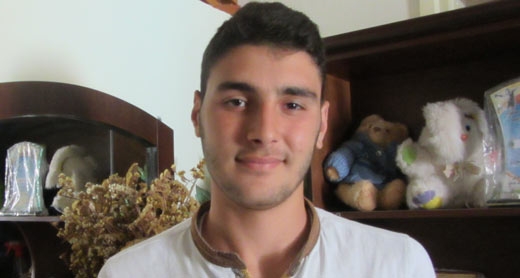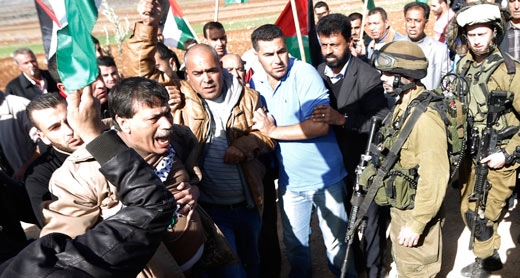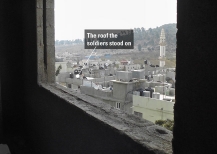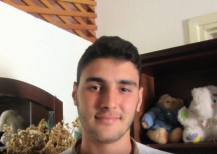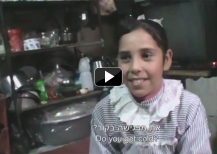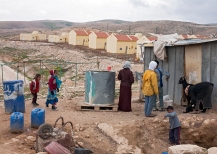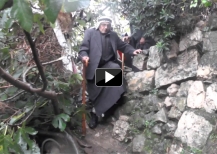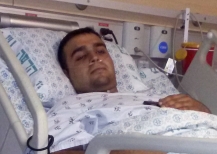۱۳۹۳ دی ۸, دوشنبه
Human Rights Day in Turmusaya, West Bank: nonviolent Palestinian protest violently dispersed
Human Rights Day in Turmusaya, West Bank: nonviolent Palestinian protest violently dispersed
Published:
10 Dec 2014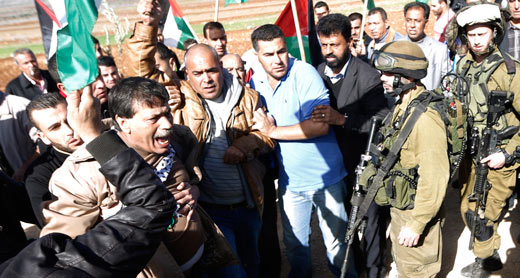
Palestinian Minister Ziad Abu Ein demonstrating today (10 Dec. 2014) at Turmusaya. Photo by Muhammad Torokman / Reuters
Worldwide attention has focused today on the death of Ziad Abu Ein, the Palestinian minister in charge of the Settlements and Annexation Wall portfolio, after he participated in a nonviolent demonstration north of Ramallah, in the West Bank. He had joined Palestinian farmers from the village of Turmusaya who were protesting today, Human Rights Day (10 December), to regain access to their land. While the circumstances of Abu Ein’s death are not yet clear, the reason for the demonstration and the way Israeli security forces handle Palestinian protests are all too familiar.
The demonstrators were holding saplings to plant on their plots of land, to which they have been barred access since the establishment of Israeli outpost Adei Ad east of their village. Such settlements, which are officially unauthorized by the state, are yet another means by which Israel has taken over land in the West Bank, excluding Palestinians from vast areas there. Although portrayed as the action of extremist settlers, the establishment of these outposts is in fact a state enterprise assisted by all government bodies, whether actively or by omission, a fact that has been well documented ( See “The Road to Dispossession” by human rights organization Yesh Din for a case study of Adei Ad, and “Access Denied” by B’Tselem for details of this policy implemented throughout the West Bank).
The protest today accompanied a High Court petition for the evacuation of the Adei Ad outpost, filed by the residents through Yesh Din. As in other cases in the West Bank, the decision to demonstrate to regain access to the land was made after all other avenues had been exhausted, including letters to authorities, legal action, involvement of international actors, media reports, and more. None of these efforts helped the landowners reclaim their property, nor did they improve the conditions of Palestinian communities harmed by the existence and expansion of the outpost.
Any form of Palestinian protest against the occupation, even when it is entirely nonviolent (as was apparently the case today) is unlawful under the Israeli martial law that applies to Palestinians in the West Bank. Israeli security forces are authorized to disperse any Palestinian demonstration, even when participants are nonviolent (see B’Tselem position paper on the right to demonstrate in the Occupied Territories), and often do so. To that end, they use crowd control weapons including stun grenades, tear gas grenades and “skunk” liquid (see B’Tselem report “Israel’s Use of Crowd Control Weapons in the West Bank”), as well as physical violence. Israeli security forces also arrest and prosecute demonstration organizers and participants, even when they are nonviolent. Needless to say, it is very rare for such measures to be taken against settlers protesting nonviolently. To the best of B’Tselem’s knowledge, and based on footage published by the media, the forces dispersed the protest today with tear gas grenades and stun grenades and also used physical violence to block the procession, in which Minister Abu Ein was participating.
The state sends settlers to forcefully take over Palestinian land in the West Bank and then sends the army to forcefully silence protest against the land grab – sometimes, at a lethal price. That is how Human Rights Day looks for people who live under occupation, where even demonstrating against dispossession is not allowed. That is what life, and sometimes death, under occupation looks like.
Le nationalisme prolifère sur le terreau du « modèle allemand » de régression sociale
|
28 décembre 2014
L’Allemagne n’échappe pas aux accès de fièvre nationalistes et identitaires qui surgissent dans de si nombreux États membres sur fond de crise du modèle actuel de construction européenne. Un mouvement « patriotique contre l’islamisation de l’Occident », dont l’un des centres névralgiques se situe à Dresde et qui agrège identitaires, néonazis ou membres du parti d’extrême droite anti-euro (AfD), parvient à mobiliser tous les lundis des milliers de personnes dans la rue. Un décryptage de Bruno Odent publié dans L'Humanité.

Dans plusieurs villes du pays, d’ouest en est, de Düsseldorf à Dresde en passant par Cologne et Rostock, des manifestations à l’appel d’un mouvement de Patriotes européens contre l’islamisation de l’Occident (Pegida) prennent une ampleur de plus en plus préoccupante. « Nous sommes le peuple », scandent régulièrement les manifestants à l’occasion de ces rendez-vous convoqués symboliquement tous les lundis, comme ceux qui ébranlèrent, il y a vingt-cinq ans, le régime de l’ex-RDA. Les organisateurs, tous issus du marigot des groupuscules ouvertement racistes, anti-islam, néonazis et nostalgiques du Reich, ont trouvé là le moyen de sortir du périmètre étroit de leurs chapelles brunes respectives pour entraîner une partie de la population.
Le nationalisme prolifère sur le terreau du « modèle allemand »
Dresde semble être devenue l’un des principaux épicentres du mouvement. Ils étaient 15 000 dans les rues de la capitale du Land de Saxe lundi dernier (soit 5 000 de plus que le lundi précédent). Le refus d’une Überfremdung (submersion étrangère), fondée sur la psychose d’être englouti par la culture, la religion des étrangers, est l’instrument privilégié de ces joueurs de flûte. Dans le défilé de Dresde, des croix peintes aux couleurs de l’Allemagne côtoient des slogans pour « la défense de l’âme occidentale de l’Europe », « chrétienne depuis l’Antiquité ». Et les appels fusent pour barrer la route d’un islam repoussoir, soigneusement amalgamé à la barbarie de Daesh en Syrie et en Irak. « Nous vivons les prémices d’une guerre civile mondiale », hurle l’un des manifestants.
L’efficacité du maniement de ces peurs, présentant les immigrés comme une cinquième colonne dans une « guerre des civilisations » remise au goût du jour, ne tient pas à un afflux relatif de réfugiés ou de demandeurs d’asile. L’Allemagne, en pleine crise démographique, est certes l’un des États de l’UE qui accueillent le plus de migrants sur son territoire. Mais ces derniers ne constituent que 2,5% de la population du Land de Saxe. Et les musulmans en représentent seulement 0,1%. En fait les arguments xénophobes de Pegida font mouche auprès d’une partie de la population parce que celle-ci est massivement fragilisée par l’insécurité sociale. Ce qui alimente une crainte diffuse de se faire « voler par les immigrés » l’emploi ou les divers dispositifs d’allocations sociales. Le nationalisme prolifère ainsi sur le terreau du « modèle allemand » de régression sociale.
Si Pegida se présente sous les traits d’un rassemblement « extraparlementaire », le parti d’extrême droite anti-euro, l’Alternative pour l’Allemagne (AfD), est à la manœuvre en coulisse. Lui, qui a fait son entrée en juin au Parlement européen et vient de faire irruption avec plus de 10% des voix dans les parlements de Saxe, du Brandebourg et de Thuringe, participe, voire appelle aux rassemblements de Pegida. Comme Hans-Thomas Tillschneider, dirigeant saxon de l’AfD, co-instigateur d’une « plate-forme patriotique » sur Internet.
La chancelière Angela Merkel a réagi en déclarant que si le droit de manifester était constitutionnel, il n’y avait « pas de place pour la haine et la calomnie de personnes qui viennent d’autres pays ». Le problème, c’est que depuis des mois l’aile bavaroise de son parti chrétien-démocrate, la CSU, mène campagne contre le « tourisme social » (sic) dont se rendraient coupables les étrangers. « Ceux qui trichent, à la porte » fut ainsi l’un de ses slogans vedettes de la campagne européenne de la CSU au printemps dernier.
Ce positionnement était censé contenir la concurrence exercée à droite par l’AfD. Résultat : le parti nationaliste progresse de scrutin en scrutin. L’Europe officielle a joué elle-même un très mauvais rôle dans ce dossier. La Cour européenne de justice a en effet conforté les chasseurs de « touristes sociaux » allemands. Par un jugement en faveur d’un office pour l’emploi germanique (l’Humanité du 13 novembre 2014), elle vient de couper largement l’accès à l’aide sociale des ressortissants étrangers venus d’autres pays de l’UE. Ce jugement a comblé d’aise les nationalistes partout en embuscade, leur revendication nauséabonde en faveur de la « préférence nationale » se trouvant, de fait, juridiquement validée. L’Europe et l’Allemagne ont besoin de changer radicalement de modèle.
Source : L’Humanité

اشتراک در:
نظرات (Atom)


